

An Ingenious Way to Save Half-Eaten Fruit, Without Plastic Baggies. Food Huggers is a line of silicone caps for keeping half-eaten fruits and veggies fresh.
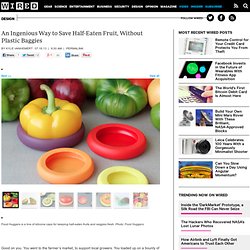
Photo: Food Huggers They come in four sizes, ensuring a snug fit on a variety of eats. Photo: Food Huggers It's a clever, non-wasteful alternative to the usual plastic baggy. Photo: Food Huggers Think of all the tomatoes you'll save! Photo: Food Huggers An Apple gettin' hugged. Photo: Food Huggers Nice orange pep gettin' hugged. The designers came up with an avocado-specific piece as a stretch goal for their successful Kickstarter campaign.Photo: Food HuggersThey come in a buncha colors, too.
Food Huggers is a line of silicone caps for keeping half-eaten fruits and veggies fresh. Good on you. In a sense, the Food Huggers were a product of guilt. Adrienne McNicholas and Michelle Ivankovic have been there too. BYO cutlery: why we should all carry our own knives and forks. In medieval Europe, people used to carry their own personal knife – a sharp one – for every eating occasion.

There was no expectation that cutlery would be provided, except perhaps for spoons. When the meal was done, the knife was wiped clean on a napkin and carefully returned to your person. The knife was worn so habitually that – as with a watch – you might start to regard it as a part of yourself and forget it was there. A sixth-century text reminded monks to detach their knives from their belts before they went to bed, so they didn't cut themselves.
Surface Pro 2: It'll end up in LANDFILLS because it can't be repaired. Teardown We knew that Microsoft's Surface Pro 2 tablets wouldn't stray too far from the original Surface Pro design - but according to the tool-and-part masters at iFixit, the new tablets are virtually identical to the old ones – meaning they're just as difficult to repair.

The Surface Pro 2 looks a lot like the original Surface Pro, and it's built the same, too iFixit's teardown of the new slate reveals that its guts are full of thick, tacky glue and more than 90 screws, just like its predecessor. A Miracle New Plastic, Made From Anything But Nasty Stuff. Plastic was once a miracle invention, but these days the wonder is wearing thin.
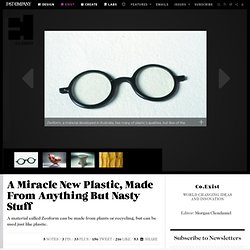
Mounting pollution, the fact that plastic has an association with toxic substances, and its fossil fuel roots are just some of the reasons people are keen to find alternatives. Cleaning up toxic waste: directed evolution vs. designed machines. Some heavy metals are required in trace amounts for the survival of living organisms, however at higher concentrations these metals can be incredibly toxic.
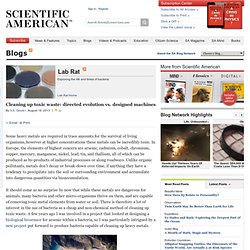
In Europe, the elements of highest concern are arsenic, cadmium, cobalt, chromium, copper, mercury, manganese, nickel, lead, tin, and thallium, all of which can be produced as by-products of industrial processes or along roadways. Unlike organic pollutants, metals don’t decay or break-down over time, if anything they have a tendency to precipitate into the soil or surrounding environment and accumulate into dangerous quantities via bioaccumulation.
It should come as no surprise by now that while these metals are dangerous for animals, many bacteria and other micro-organisms thrive on them, and are capable of removing toxic metal elements from water or soil. There is therefore a lot of interest in the use of bacteria as a cheap and non-chemical method of cleaning up toxic waste. The Berkeley Pit, a former copper mine in the USA. Digest this! Cutting edge technology converts organic waste into organic fertilizer in just one day It normally takes several weeks at best for a traditional composter to turn its contents into a useful end product.
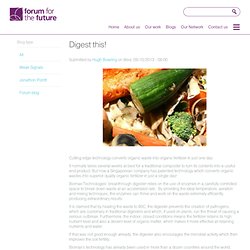
But now a Singaporean company has patented technology which converts organic wastes into superior quality organic fertilizer in just a single day! Biomax Technologies’ breakthrough digester relies on the use of enzymes in a carefully controlled space to break down waste at an accelerated rate. By providing the ideal temperature, aeration and mixing techniques, the enzymes can thrive and work on the waste extremely efficiently, producing extraordinary results. It’s about to get easier to 3D print with recycled plastic. 3D printers generally print in one of two types of plastic; either ABS, which is used to make Legos, or PLA, typically found in some types of food packaging.
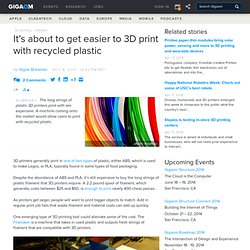
Despite the abundance of ABS and PLA, it’s still expensive to buy the long strings of plastic filament that 3D printers require. A 2.2 pound spool of filament, which generally costs between $25 and $50, is enough to print nearly 400 chess pieces. As printers get larger, people will want to print bigger objects to match. Add in regular print job fails that waste filament and material costs can add up quickly. One emerging type of 3D printing tool could alleviate some of the cost.
Voxelfab recently had the chance to catch up with Filamaker creator Marek Senicky, who demoed the machine at the Rome Maker Faire. The Filamaker works by grinding down and melting old pieces of plastic. Filamaker will compete with machines like the Filabot, which turns relatively inexpensive plastic pellets into filament.